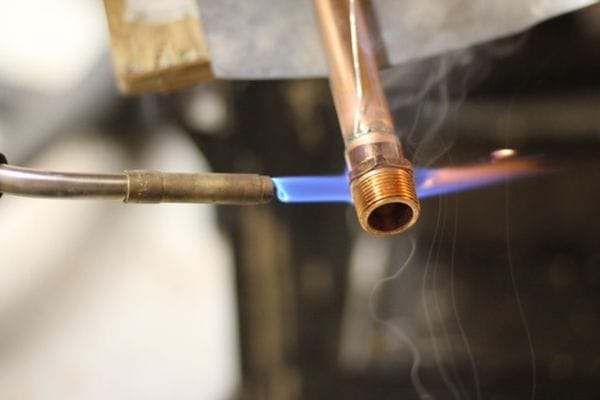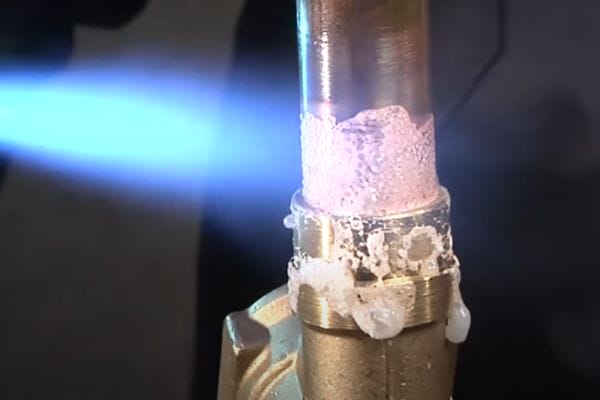Soldering copper pipe to brass fittings is a critical skill in the fields of plumbing and HVAC (heating, ventilation, and air conditioning). The goal of this post is to provide a comprehensive, step-by-step guide on how to effectively solder copper pipe to brass fittings.
Before diving into the soldering process, it’s crucial to gather all the necessary materials and tools. Having everything at hand will ensure a smooth and efficient workflow, minimizing interruptions and enhancing safety. Here’s a comprehensive list of what you’ll need:
Copper Pipe: The primary material for the pipe sections of your project. Choose the correct diameter and length for your specific needs.
Brass Fitting: Used to connect different sections of copper pipe or to join copper pipe to other types of pipe. Brass fittings are available in various configurations such as elbows, tees, and couplings.
Lead-Free Solder: Essential for creating a strong and safe bond. Lead-free solder is particularly important for potable water systems to prevent lead contamination.
Flux: A chemical cleaning agent that helps the solder flow and bond properly by cleaning the metal surfaces and preventing oxidation.
Emery Cloth or Sandpaper: Used to clean and prepare the surfaces of the copper pipe and brass fitting, ensuring a good bond.
Pipe Cleaning Brush: A cylindrical brush designed to clean the inside of copper pipes and fittings.

Pipe Cutter: A specialized tool for cutting copper pipes cleanly and accurately. Ensure it’s sharp and in good condition for the best results.
Torch: A propane or MAPP gas torch is used to heat the joint to the correct temperature for soldering. The torch should have a precise flame control feature.
Safety Gear: Includes heat-resistant gloves, safety goggles, and a long-sleeve shirt to protect against burns and splashes.
Heat Shield: A protective barrier to shield surrounding areas from the torch’s flame, preventing accidental fire hazards.
Adjustable Wrenches: For holding and adjusting the fittings securely during the soldering process.
Tape Measure: To measure the length of the copper pipe accurately before cutting.
Marker or Pencil: For marking cutting lines on the copper pipe.
Deburring Tool: Used to remove burrs from the cut end of the pipe, ensuring a smooth, clean edge.
Copper and brass are highly valued in plumbing and HVAC systems due to their distinct and complementary properties.
Copper and brass are both highly resistant to corrosion, which is essential for long-lasting plumbing and HVAC systems. This resistance ensures that the pipes and fittings maintain their integrity and functionality over time, reducing the likelihood of leaks and system failures.
Copper has excellent thermal conductivity, making it an ideal material for heating and cooling applications. This property allows for efficient heat transfer.
Brass fittings offer superior strength and durability, capable of withstanding high pressure and temperature variations. This makes brass an excellent choice for connections that require a robust and reliable seal.
Safety First
Safety is paramount when working with tools and materials that involve high heat and potentially hazardous substances. Here are essential safety tips to follow:
Cutting the Copper Pipe
Accurate measurement and clean cuts are essential for a successful soldering job. Follow these steps to measure and cut the copper pipe:
Cleaning the Pipe and Fitting
Proper cleaning ensures that the solder bonds effectively to the copper pipe and brass fitting:
Applying the Flux
Proper application of flux is critical to ensure a strong bond:
Inserting the Copper Pipe into the Brass Fitting
Ensuring a snug fit without forcing the pieces is key to a successful joint:

Heating the Joint
Proper heating is crucial for a strong, leak-free joint:
Applying the Solder
Applying solder at the right moment ensures a secure bond:
Allowing the Joint to Cool
Letting the joint cool properly ensures the solder solidifies correctly:
Identifying Cold Joints:
Cold joints occur when the solder does not melt properly or does not adhere correctly to the pipe and fitting, resulting in a weak, unreliable connection. Identifying cold joints is crucial to ensure the integrity of your plumbing or HVAC system.
Fixing Cold Joints:

Too Much Thread Sealant
Applying too much thread sealant, whether Teflon tape or pipe dope, can interfere with the threading process. Excessive sealant can prevent the threads from fully engaging, leading to leaks or weakened connections.
Too Little Thread Sealant
Applying too little thread sealant can leave gaps in the threads, allowing fluids or gases to escape. Inadequate coverage fails to create a proper seal, making leaks more likely.
Incorrect Pipe Alignment
Misaligned pipes can place undue stress on the fittings, leading to leaks and potential damage. Pipes that are not properly aligned can cause fittings to warp or fail, compromising the entire system.
Excessive solder can create problems such as blockages inside pipes, unsightly joints, and potential weak points. Here’s how to manage and prevent it:
Fixing Excessive Solder:
Diagnosing Leaky Joints:
Leaky joints can compromise the efficiency and safety of your plumbing or HVAC system. Identifying and diagnosing the cause of leaks is essential:
Repairing Leaky Joints:
In conclusion, soldering copper pipe to brass fittings involves several critical steps: ensuring safety, cutting and cleaning the copper pipe and fittings, using the correct flux, assembling the copper pipe and fittings together, properly heating the joints, and applying the solder correctly. Remember to troubleshoot common faults such as joints that are too cold, too much solder, and leaky joints to ensure a long-lasting, leak-free connection. Practice your soldering skills on scrap to gain confidence before making actual repairs. We invite you to share your experiences, ask questions and provide feedback. Your insights and questions are invaluable and help us improve our work.
Use a water-soluble flux specifically designed for plumbing applications. This type of flux is safe for potable water systems and helps ensure a strong, clean bond.
The joint is ready for soldering when the flux begins to sizzle and bubble. This indicates that the metal surfaces are hot enough for the solder to flow and bond properly.
Ensure the joint is evenly heated. If the solder still doesn’t flow, reapply a small amount of flux and heat the joint again to ensure proper adhesion.
Yes, lead-free solder designed for plumbing applications is suitable for both copper and brass. It ensures a safe, durable connection, especially in potable water systems.
Use an emery cloth or sandpaper to clean the surfaces until they are shiny and free of oxidation. This ensures a strong bond between the solder and the metal surfaces.
Ensure that the joint is properly cleaned, fluxed, and heated. Apply the solder evenly around the joint and allow it to cool naturally without disturbance. Performing a pressure test after cooling can help verify that the joint is leak-free.